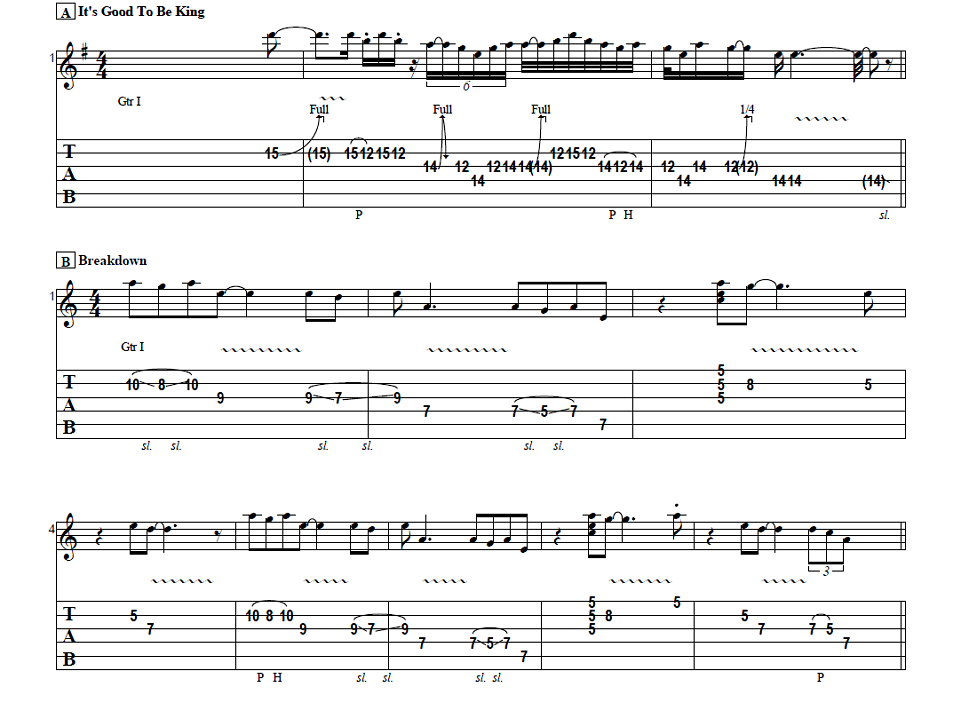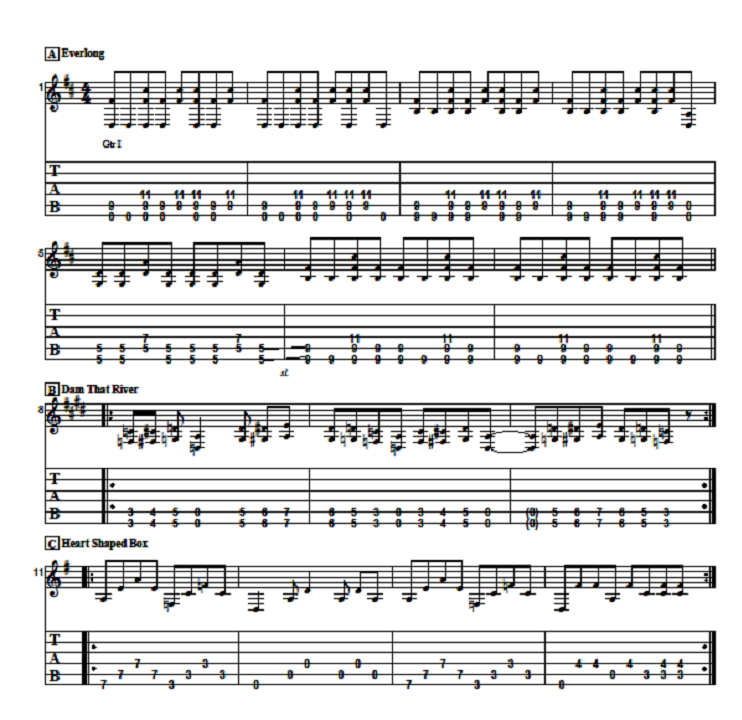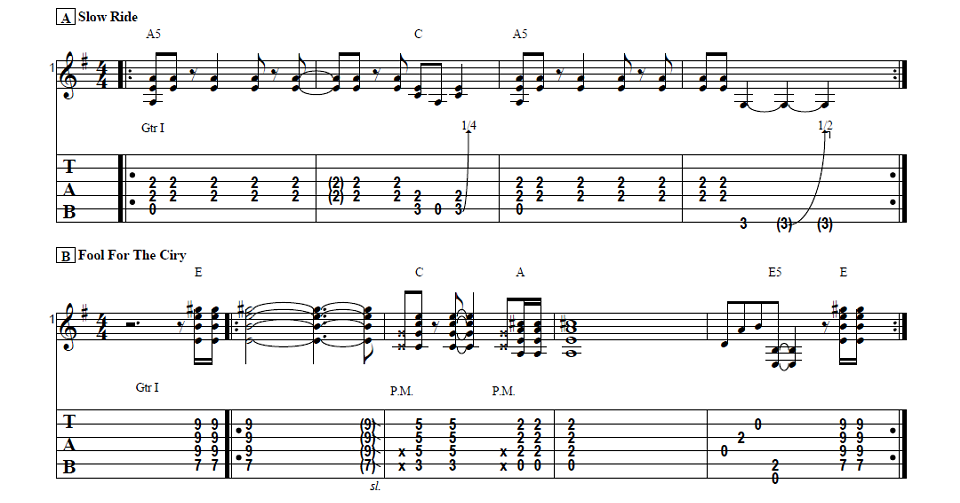Hey, this is Darrin Goodman from Guitar Control, I want to show you 3 power chord riffs, but they’re not your traditional power chord riffs. They’re still D-Y-A-D-S, two note chords. But instead of looking at the 5th that you’re probably used to playing, we’re going to be looking at some other intervals including 4th, 3rd, major thirds and minor third.
Click on the Tabs button to follow chords and tabs.
[ninja-popup ID=715]
The first riff that we’re going to look at is “Youth Gone Wild” by Skid Row. So this riff starts off, on the 4th and the 3rd string open. And then we’re going to do a slide from nowhere to the 5th fret of the 4th and 3rd string. This whole riff is based on the 4th and the 3rd string, just different intervals. So we slide that to the 5th fret and I like to use my third finger to do this. And then to the 3rd fret with my first finger. And then back to the open strings.
So since there are two open strings and on the same fret of the 3rd and same fret of the 5th fret, that interval is the 4th. Then we go to the 3rd fret of the 4th string with your second finger and 2nd fret of the 3rd string with your first finger. And that interval shape is for the a major third. So this is F but it’s just the root of the third, the major third.
And then we just take your second finger and lay it down across the 3rd fret of the 4th and the 3rd string. Then we follow that with the open 4th and 3rd string again and we do it again. Now we move with our first finger to the 1st fret of the 4th string, third finger to the 3rd fret of the 3rd string. And then back to that original riff again. So the whole sequence slowly.
Next we have “It’s Not Love” by Dokken. This riff is also on the 4th and 3rd string. So we start off, and come down to the 7th fret of the 4th string with your first finger and the 9th fret of the 3rd string with your third finger. Now how I’m playing this, instead of playing with the pick I’m actually going to use these two fingers. You could also do it by pinching, but I like to do it this way so I can keep a hold of the guitar pick. And then just do the plucking of the strings with my second and third finger.
So we start off, we’ve just got that basic power chord shape that I’m sure you’re familiar with. And this riff is based in 8th notes. So we have 1 and 2 and 3 and 4. And then on four, you flatten the note on the 3rd string a half step. So we’re going to go from the 9th fret to the 8th fret. And I’m going to use my first finger. So …
And put just a skosh of vibrato on there. And that’s on four, but it’s tied to the downbeat of one of the next measure. So it’s like 1 and 2 and 3 and 4 and 1 and 2 and 3 and 4. You just stay on that same shape of the 2nd shape, the 7th fret of the 4th string with your first finger and the 8th fret of the 3rd string with your second finger.
Then we do a slide from nowhere to the 5th fret of the 4th and 3rd string. And I’m going to use my first and second finger to do this. So it’s the same thing before we’re starting that on the downbeat of one. 1 and 2 and 3 and 4 and then on the four we flatten the note on the 4th string from the 5th fret to the 4th fret and use my first finger. That’s on the four with a little vibrato. And then that’s tied to the downbeat of one of the next measure. And then you finish off that next measure and two and three and four. So the whole sequence slowly. And that’s [inaudible 00:06:02].
Finally we have “The Zoo”by The Scorpions. This riff, has the D-Y-A-D shapes that are going to be on the 5th and 4th string this time. And we’re going to be pedaling the open 6th string. So the pedal for the open six string, it’s this triplet kind of a thing here we got going here. So it’s like 1 and 2 and 3. It’s like down, up, down, up, down, up, down, up, down. And you palm mute it.
And then, so that’s the first three beats. And then on beat four we go to the D-Y-A-D shapes. So in this case we’re going to be on the 12th fret of the 5th string with your third finger and the tenth fret of the fourth string with your first finger. And we’re going to play that shape and then we’re going to move down. So we go on the fifth string, we go to the tenth fret. And on the fourth string we go to the ninth fret. So this first shape here, I’m using my third finger on the twelfth and my first finger on the tenth. And then we’ll move down. I just simply move my first finger down from the tenth to the ninth fret and then drop my second finger onto the tenth fret. So … just like that. So that’s the first measure.
So on the second measure we do the same thing. So that’s the first two measures. And then on the third measure, it’s a little bit different. We have that same triplet feel but now, it’s a little different. There’s a little bit more changes. So we start off with just the single six string open. Palm muted. And then we’re on the ninth fret of the fifth string with your third finger and the seventh fret of the fourth string with your first finger. So we do the pedal the open six … Pedal it again and now we move down so we’re at the seventh and sixth fret. Or excuse me, seventh and fifth fret. So … and then we pedal again back up to seven and nine. Pedal again up to ten and nine.
So … so far we have … then it simply just starts, it basically starts over again. So what you played on the first two measures, you also do that on the fourth, fifth and sixth measures. So you just repeat that riff three more times.
So on that last one, it’s a variation of just of the other change. So we go from that 10th fret of the 5th string, 9th fret of the 4th string. To 9 and 7 to 7 and 5 back to 9 and 7 and then we stop. Then it ends is on the 7th fret of the 5th string and 5th fret of the 4th string. So the whole sequence slowly.
I hope you got something out of that and you enjoyed the lesson. If you liked this lesson, give me a thumbs up, leave me a comment down below if there’s anything you’d like to see either myself or one of the other instructors at guitarcontrol.com do in a future lesson. Make sure to subscribe on our You Tube Channel and we’ll see you in our next video lessons, thanks for watching.





